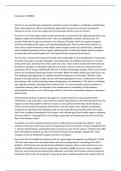Student ID: 33498016
The liver is an essential organ needed for metabolic survival. Its ability to metabolise carbohydrates,
lipids, and proteins are vital for providing the body with the necessary nutrients and minerals
integral to survive. It also has a large role in homeostasis and the removal of waste 1.
The liver is one of the largest organs in the human body. It is located in the right hypochondriac and
epigastric region of the abdominal cavity 2, above the gallbladder, stomach, and pancreas. It is
located within the rib cage for protection. It is made up of lobules, which are regular hexagonal
structures throughout the organ, each containing hepatocytes. At the corner of each lobule is a
triad, which contains branches of the hepatic artery, hepatic portal vein, and bile duct 2. Between
each individual hepatocyte cell are regions called sinusoids, in which the hepatic portal vein drains
the blood into the central hepatic vein 2. This blood is then transported to the heart.
The liver has a myriad of functions in the body and is responsible for the detoxification of molecules,
formation of proteins, storage of glycogen, and maintenance of metabolic homeostasis 3. The liver
breaks down toxic ammonia from amino acids into urea 1, which is then excreted from the body via
the kidneys. Similarly, it metabolises ethanol into acetate, which can then be used by the body to
synthesise ATP for energy. Additionally, the liver is involved in glycogen storage, which is an essential
process of maintaining blood sugar levels in the body. When the body’s blood sugar level is low, the
liver undergoes glycogenolysis to maintain normal blood glucose concentration. Similarly, when
glucose is too high, glucose is taken up into cells where glycogenesis occurs. Furthermore, the liver
also produces bile, a fluid containing waste, bile pigments, and cholesterol 4. This aids in emulsifying
fats, digestion of foods, and disposal of red blood cells 4. It is also involved in protein synthesis. It
synthesises albumin, which is important in the maintenance of osmolarity. It also produces
anticoagulation proteins, such as fibrinogen which is used in the homeostatic response of damaged
blood vessels.
Unfortunately, the liver can become damaged as a result of disease or excess alcohol intake.
Medications, such as diuretics5, can be given to reduce blood pressure, thus relieving stress from the
hepatic vessels. Many patients with liver disease are also advised to limit their alcohol intake, to
reduce any worsening of symptoms and the liver’s overall function. Also, patients considering a
transplant are advised to stop drinking, as this can adversely affect the function of the new organ,
and is also considered disrespectful to the donor, who willingly gave their healthy organ to someone
who may need it6. A damaged liver can no longer regenerate new hepatocytes to form new tissue,
due to the damage caused.
Transplants are only considered when the body is suffering from end-stage liver disease 5. A few
examples of diseases which may require transplantation are primary biliary cirrhosis, hepatitis B and
C, alcohol-related disease, and hepatocellular carcinoma (a type of liver cancer) 7. Patients who suffer
from end-stage liver disease are also more likely to develop renal damage 7. Despite this, renal
damage can also be hindered if a patient receives a transplant.
Due to the lack of available liver donors in the UK, most people are placed on a waiting list. In 2021,
739 livers were taken from deceased donors and 20 from living donors 8. According to the 2020
statistics, 16178 people were placed on the waiting list. However, there is much controversy as to
whether an individual who is not an organ donor, should be eligible to receive a liver transplant.
There are several arguments favouring the individual, one being, that refusing a patient treatment,
based upon their choice of not being an organ donor goes completely against the medical ethics of




